Van Gogh Museum Journal 2003
(2003)– [tijdschrift] Van Gogh Museum Journal–
[pagina 56]
| |
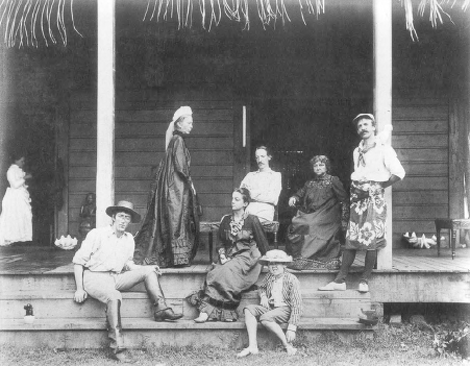 fig. 1
Stevenson family group on the veranda at Vailima, 1892, Edinburgh, Writers Museum | |
[pagina 57]
| |
A Frenchman and a Scot in the South Seas: Paul Gauguin and Robert Louis Stevenson
| |
Journeying to the South SeasStevenson left for his South Seas journeys some three years before Gauguin. In 1888 he chartered a gracious schooner, the Casco, from San Francisco, risking two thirds of the sum he had inherited on the death of his father the previous year. Ultimately he was banking on the trip being financed by Sam McClure, editor of the New | |
[pagina 58]
| |
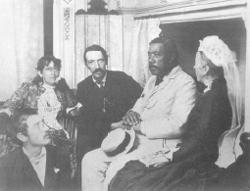 fig. 2
In the State Room of the Casco, with Fanny, Robert Louis Stevenson, King Kalakaua, Mrs Thomas Stevenson and Lloyd Osbourne, 1889, Edinburgh, Writers Museum York World, who commissioned him to write regular letters describing the experiences of his voyage and to make a photographic record, which would be syndicated around the world. Although he had originally intended to go back to his homeland, by 1890, having made three such voyages around many of the Pacific Island groups, Stevenson had resolved to return neither to Scotland nor to America, where he had latterly been living, but to settle on Western Samoa. He found the climate of the tropics beneficial to his extremely delicate health. Thus, with his American wife Fanny and stepfamily, Stevenson set up home on quite a lavish scale in what became Vailima (fig. 1). The writer was quick to adopt the brightly coloured local pareo, or ‘kilt,’ as he called it. Their initial journeys had already taken the Stevenson family party to the Marquesas Islands, which, setting out from San Francisco, was their first landfall. They next spent nine weeks on Tahiti, between October and December 1888, staying at Tautira, a spot on the north coast of Tahiti's southern peninsula. They were befriended and looked after by the family of local chieftain Ori a Ori, whose mother, Princess Moe, was a fund of information on local folklore. Similarly, on visiting Honolulu they met King Kalakua, with whom they were photographed on board (fig. 2). The photograph must date from just before the writer's recently widowed mother, who had travelled with them for the first year, returned to Scotland. Next stages on the voyage were the Gilbert Islands (now known as Kiribati), Samoa, New Caledonia, Australia and New Zealand. The journeys and island visits bore fruit in books and tales including The beach of Falesa, The wrecker (both 1892) and The pearl-fisher or The ebb-tide (published in instalments in two separate journals, 1893-94).Ga naar voetnoot6 But prior to this, the non-fiction letters recording aspects of life and the customs of Polynesia that eventually made up In the South Seas, started to appear weekly, while Stevenson was still writing them, which put him under considerable pressure. Somewhat monotonous in tone compared to his fiction, they were published from early 1891 onwards in journals in Australia, New Zealand and on both sides of the Atlantic. A new journal, Black and White: A Weekly Illustrated Record and Review won the rights in London. To illustrate the letters, Stevenson sent various materials, including some of his own photographs and those of professional photographers, which were to be used as the basis for wood engravings (figs. 3 and 4). Arcadian life at Butaritari - Mr and Mrs R.L. Stevenson with Nantoki and Natakariti appeared in the first instalment of ‘The South Seas: a record of three cruises’ in the Black and White of 6 February 1891;Ga naar voetnoot7 the Marquesan warrior also appeared on 11 July 1891.Ga naar voetnoot8 The desire to install himself in the ‘Studio of the Tropics,’ rather than just making an exploratory visit as he had done in 1887 to Martinique, took hold of Gauguin in late 1888, when he was staying in Arles with Vincent van Gogh.Ga naar voetnoot9 Their discussions often turned on the subject, the practicalities as well as more utopian fantasies. Never totally impractical, Gauguin's dreams of tropical paradise seem always to have concentrated on French colonial possessions, first Tonkin, then Madagascar, and eventually, in late 1890, Tahiti. Of course Gauguin had no need to be aware of the precedent set by Stevenson to whet his appetite for exotic travel. He had plenty of other stimuli: for one, the 1889 Paris Exposition Universelle, with its colonial exhibitions. There was also a tradition of exotic literature in France, particularly Pierre Loti's colourful book Le mariage de Loti (1881), set in Tahiti, which describes the | |
[pagina 59]
| |
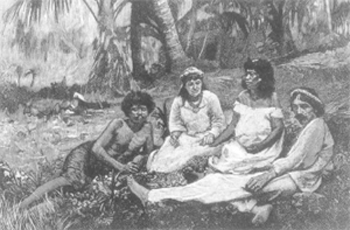 fig. 3
Arcadian life at Butaritari - Mr and Mrs R.L. Stevenson with Nantoki and Natakariti, from Black and White 1 (6 February 1891), p. 23, Edinburgh, National Library of Scotland, The Trustees of the National Library of Scotland author's own visit to the island in 1872. Urged on by Van Gogh, we can be sure that Gauguin read Loti. Gauguin left Marseilles and travelled to the Pacific via the Suez Canal in April 1891. He thus approached Tahiti from the Australian not the Marquesan side. He spent two productive years on Tahiti, quickly moving away from the capital Papeete to the more remote Mataiea (not far from the southern peninsula of Tautira where Stevenson had stayed three years before). On Gauguin's 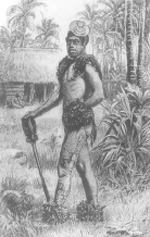 fig. 4
Marquesan warrior, from Black and White 2 (11 July 1891), p 52, Edinburgh, National Library of Scotland, The Trustees of the National Library of Scotland return to Paris in 1893, Stéphane Mallarmé was curious to see the fruits of his labours and to quiz the painter on his experiences. | |
The Mallarmé connectionIt would seem that Mallarmé first came to know Paul Gauguin over the winter of 1890-91, when Gauguin was marshalling the most influential support he could to help raise the money for his first voyage to Tahiti. Indeed, | |
[pagina 60]
| |
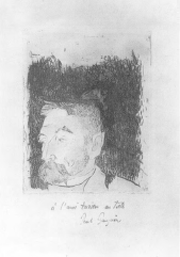 fig. 5
Paul Gauguin, Portrait of Stéphane Mallarmé, 1891, Paris, Bibliothèque Nationale de France Mallarmé played a significant role in securing for Gauguin the services of Octave Mirbeau, who wrote an influential article about Gauguin's planned adventure for the Figaro. Mallarmé also presented the toast at a farewell banquet for Gauguin in March 1891. Gauguin's etched portrait was made by way of a reciprocal homage to the symbolist poet (fig. 5). As Françoise Cachin has observed, Mallarmé was a passionate admirer of Stevenson's writing. Of course, as a fluent English speaker and one time teacher of English, he could read Stevenson in the original. Witness the fact that his library at Valvins contains the complete Edinburgh edition of Stevenson's writings, published posthumously in 1896.Ga naar voetnoot10 It is clear, however, that he was already well acquainted with Stevenson's writings even before this date. He had himself contributed articles in 1892-93 to the National Observer, a journal which not only published occasional pieces by Stevenson, but whose editor, W.E. Henley, had been Stevenson's close collaborator and friend. In 1893 Edmond Gosse brought out a new book entitled Questions at issue, in which he devoted chapters to Mallarmé's symbolism and to Stevenson's poetry, respectively.Ga naar voetnoot11 In 1896, two years after Stevenson's death, it was natural for the Edinburgh committee - anxious to establish a memorial to Stevenson in France - to ask Mallarmé, one of the writer's warmest and most eminent French admirers, for support.
Over 40 of Gauguin's Tahitian paintings were exhibited at the Durand-Ruel gallery in November 1893. The artist deliberately varied the fare on show, some paintings being more difficult and symbolist than others. If Manaò tupapaú (The spirit of the dead keeps watch) of 1892 (Buffalo, Albright-Knox Art Gallery) belonged to the former category, Black pigs (fig. 6) exemplified the latter; indeed it was not dissimilar to the watercolour views of Vailima painted from photographs by Count Girolamo Nerli. However, when Mallarmé was asked by Charles Morice to write a promotional article about Gauguin's exhibition, and ‘to point out the analogies with and differences to the parallel movement in literature,’ he declined - sadly for my investigation.Ga naar voetnoot12 For if he had read any of Stevenson's recent writings about Polynesia, he would perhaps have had some pertinent questions to pose, or parallels to draw. Despite this refusal, letters from Gauguin to Mallarmé in 1893 and 1895 reveal that they had several meetings and talks and maintained cordial relations. Unquestionably, Gauguin set much store by making a favourable impression on Mallarmé, just as in the artistic sphere he valued the high opinion of Degas. He was fond of quoting Mallarmé's verdict on his Tahiti work: ‘It is extraordinary that one can infuse so much brilliance with so much mystery.’ For example, he reported it in a letter of 1899 to André Fontainas, shortly after Mallarmé's death, sending the editor of the Mercure de France a copy of his etching of the poet.Ga naar voetnoot13 Mallarmé is a precious link because one of the key questions that has guided my research is whether Gauguin knew of Stevenson's presence in the South Seas. Frustratingly, thus far Gauguin's letters and writings seem to make no allusion to Stevenson. (We eagerly await publication of Victor Merlhès's fully annotated edition of Gauguin's later correspondence.) Nor does the English-speaking Van Gogh, Gauguin's regular correspondent in this period, seem to have mentioned Stevenson at any juncture. Given these lacunae, one might ask whether one | |
[pagina 61]
| |
should have bothered to look any further. However, I think there are a number of good reasons for doing so. | |
Stevenson's reputation in FranceWhile it is doubtful that Stevenson would have had any reason to hear of Gauguin - in terms of public recognition Gauguin's career lagged far behind his - there are considerable grounds for suggesting Gauguin would have been aware of Stevenson. Stevenson was becoming an internationally famed figure in the late 1880s. Although the extent of his reputation in France is still a relatively under-researched question, we know that the writer was a confirmed Francophile and took a great interest in his critical standing in the country. He had spent many years living in France, making different rural areas the subject of some of his earliest non-fiction - for example, An inland voyage of 1878, and Travels with a donkey in the Cévennes of 1879. His style was once described as more ‘French than English and more English than Scots.’Ga naar voetnoot14 Stevenson mixed with painters, and he made his presence felt in the artists' colony of Grèz-sur-Loing, near Barbizon, between 1875 and 1877, in the company of his cousin, the painter and art critic R.A.M. Stevenson (1847-1900). Indeed, he wrote a number of articles about bohemian artistic life in Paris and the forest of Fontainebleau.Ga naar voetnoot15 However, according to one of his painter friends, the American Will Low, he had little appreciation of painterly form and colour.Ga naar voetnoot16 If Gauguin had heard of Stevenson and of his trip to the South Seas, can we next say when he would have gained this knowledge: before hatching his own similar project in 1888? Before embarking on it in April 1891? Whilst back in France in 1894? Or whilst in Tahiti? I will attempt to answer these questions stage by stage, in chronological order. First, and most speculatively, could Gauguin have already been aware of Stevenson as an author in the mid-1880s? Were he to have come across it, it is likely he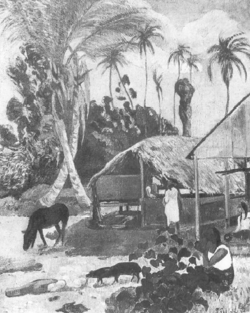 fig. 6
Paul Gauguin, Black pigs, 1891, Budapest, Museum of Fine Arts | |
[pagina 62]
| |
would have empathised with the book that made Stevenson's name internationally, Treasure Island; Hetzel published it in France as L'île au trésor in 1885 in an illustrated edition.Ga naar voetnoot17 After all, Gauguin himself was a father of boys, a former merchant seaman and a lover of the sea. He revelled in his reputation as a seasoned sailor. But 1885 was the year when Gauguin first broke loose from his family ties and although he had his son Clovis with him in Paris, poverty probably precluded seeking out exciting new reading matter for the boy.
It is also worth pondering whether The strange case of Dr Jekyll and Mr Hyde, another of Stevenson's best-known works and one that gained an international reputation, might have passed across Gauguin's horizons in the mid-1880s. Published in 1885 and translated into French in part by 1888, this highly coloured story became such an influential work because its gruesome study of a split personality, its exploration of the ‘beast within,’ tapped into contemporary psychological thinking about the fragmented nature of the self. Is it any more than a coincidence that Gauguin began to write about himself in similar terms around this time, as in the following letter to his wife of late January or early February 1888? ‘You have to remember that I have two natures - the savage and the sensitive. My sensitive side has disappeared, which enables the savage to advance resolutely and unimpeded.’Ga naar voetnoot18 Throughout that year he would cultivate the image of himself as a Peruvian savage. This is not to suggest that Gauguin needed to have read Jekyll and Hyde himself - merely that as a result of its runaway success, discussion of split personalities would have been in the air. Unquestionably for Gauguin, the notion proved a convenient peg on which to hang his artistic persona and problematic social relations. Although not a linguist himself, Gauguin had contact with numerous English speakers, particularly in Brittany, who would most likely have been familiar with and talked about Stevenson's work. A second and more likely possibility to consider is whether Gauguin already knew of Stevenson's presence in the South Seas before leaving France for Tahiti in April 1891. The main conduit by which French readers were kept informed of Stevenson's writings and movements was Marcel Schwob (1867-1905), a relatively obscure young writer who would later join Mallarmé's circle. Schwob was an out-and-out Stevenson fan.Ga naar voetnoot19 Although the two never met, he corresponded with Stevenson from 1888 onwards; after the latter's death, he even made the lengthy pilgrimage to Samoa, in the process contracting a tropical infection that put his own life at risk. Stevenson wrote an important letter to Schwob in August 1890 whilst in Sydney and about to settle in Samoa, overjoyed to find a genuine admirer in France, the country he regarded as supremely artistic. Two months later, Schwob used it as the basis for an article on Stevenson.Ga naar voetnoot20 Schwob had first written about Stevenson in 1888 in Le Phare de la Loire, and drawn his readers' attention to the longer appreciation Thérèse Bentzon had just devoted to Stevenson's recent writings in the Revue des Deux Mondes.Ga naar voetnoot21 In 1890, Schwob's portrait of the artist was highly romanticised and none too accurate: ‘Bring on a Scottish mountain dweller, still intoxicated with the heather perfume of his homeland; set him to the harsh regime of the most solid classical education imaginable; break him in to modern erudition and just look at the extraordinary temperament that will spring forth from such constraint. Ten years of literary life will not dampen his first impressions, they will appear to him with the same vibrancy and ardour as in the fire of youth; the | |
[pagina 63]
| |
objective admiration and lack of egoism [you find] in him will be as striking as in a 15-year-old reading Robinson Crusoe; he would abandon the warmest of homes, the easiest of lives and most-loved of parents to embark on a sea voyage and build his hut on a desert island.’Ga naar voetnoot22 Having thus built up his hero, Schwob went on to explain, quoting Stevenson's recent letter, that this was no hypothetical image, alas: ‘And now he informs me of the strangest news: he is settling in Apia, in the Samoas, with his wife and his stepson. No flight of fancy this... Stevenson may never see Europe again. His heart has been captivated by the infinitely blue South Seas, pounding the coral reefs with white surf; he has chosen to stay under a sky filled with new stars. But if the man is lost for Europe, the artist will send us marvellous works that have flowered under the Southern Cross. He promises us a Wrecker and a Pearl fisher. “A story horrible, blackly gesticulative, full of extraordinary scenes and surprising characters.” Then again he is “waist-deep” in a great book on the South Seas. It will be, he says, “the book of the South Seas.”’Ga naar voetnoot23 The timing of the appearance of this article suggests Schwob wrote it as soon as he heard the news from Stevenson. It appeared both in the national daily L'Evénement on 11 October 1890 and in Le Phare de la Loire on 15 October. One might hazard a guess that Le Phare de la Loire was distributed throughout the west of France, including Brittany; however one cannot be sure Gauguin read either paper. At the very least, we can say that were he to have done so, the content would surely have struck a chord, poised as he was on the verge of setting sail for his own tropical island. And we have documentary evidence that Stevenson's South Seas travels and ambitious artistic undertakings were being discussed in France before Gauguin's departure, particularly in elite literary circles. These facts could thus conceivably have been known to Gauguin at the time, indeed at about the period when he finally fixed on Tahiti. Another artist has been cited as providing a possible link between the ambitions and undertakings of Stevenson and Gauguin in the South Seas: the Australian painter John Peter Russell (1858-1930), who came to live in Europe in the 1870s, studying first as an engineer, then as an art student. Following a period in London at the Slade, Russell joined the Cormon studio in Paris, where he became friendly with Vincent van Gogh. In the first volume of her biography of Matisse, Hilary Spurling mentions as an aside that Russell, who had sailed the Pacific Ocean and visited Tahiti in his youth, may have been responsible for suggesting it as a destination to both Stevenson and Gauguin.Ga naar voetnoot24 However, there is little hard evidence to substantiate the claim. Independently wealthy, Russell was admired as a painter and cultivated as a collector by Van Gogh, who strongly hoped he would buy some of Gauguin's work in 1888 in order to help his friend out of his financial difficulties. Although Russell settled on the island of Belle-Ile, off the south coast of Brittany, where he met Claude Monet in 1886, it would appear that he kept a wary distance from Gauguin. But there is certainly the possibility he talked of the Pacific in conversation or in letters to Van Gogh.Ga naar voetnoot25 The likelihood that Gauguin heard talk of Stevenson during either his first or second visit to Tahiti is also reasonably high. There would surely have been fresh memories of the dramatic scenes on the arrival three years earlier of ‘le grand littérateur anglais’ [sic]. In 1894, when Marcel Schwob wrote an introduction to his translation of Stevenson's The wrecker (Le dynamiteur), he quoted a firsthand description by a young French tourist | |
[pagina 64]
| |
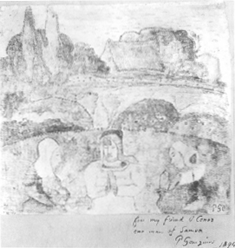 fig. 7
Paul Gauguin, The angelus in Brittany, 1894, private collection present at Stevenson's arrival in Tahiti in September 1888. This witness, one Desfontaines, described seeing Stevenson disembarking, coughing mouthfuls of blood: ‘he thought he was going to die; he was vomiting mouthfuls of blood; and this foreigner with the pale, gentle, evangelical face, framed by his long hair, arriving in this way from a distant land as though to die in Tahiti, had so moved the natives of Tautira that they did not know how to express their sympathy. All, one after another, paid him a visit, and to be kind to him one brought him a fowl, another a sucking pig. He received such quantities of fruit that he could have filled a whole room with it.’Ga naar voetnoot26 The last possible point of contact between Gauguin and Stevenson during the latter's lifetime is also perhaps the most plausible. When he first went to Pont-Aven in 1886, Gauguin stepped into what was already an international rural artists' colony, and when he returned for the last time in 1894, between his Tahitian trips, that international character had not changed. By now, however, a number of the painters who flocked there were drawn by the reputation of his own stylistic innovations. Several of the many British and American artist-visitors to Pont-Aven had also spent time in Grèz-sur-Loing, most notably, for my investigation, Roderic O'Conor. An Irish artist and a former pupil of Carolus-Duran - as was R.A.M. Stevenson - O'Conor resided at Grèz in 1889-90, well after Stevenson's time, and was friendly with various American artists there. It seems probable that talk would occasionally have touched on Stevenson the author, by then a name to conjure with, and his romantic meeting in Grèz with the intrepid American Fanny Osbourne, who had since become his wife. It is highly probable that some of the company read his books. Armand Seguin, friend of O'Conor and fervent admirer of Gauguin, indicates O'Conor was a keen reader in a letter of 1897, describing the difficulty he had had in keeping up his end in intellectual circles in Brussels, where talk had been about such topics as Walter Pater and Stevenson: ‘I wished you had been there, you would have been happy in that milieu.’Ga naar voetnoot27 If my supposition is correct, Stevenson's adventure in the South Seas would have been an obvious point of reference for O'Conor when he met Gauguin, probably for the first time, in 1894, as it would have been for any British artist meeting Gauguin at this juncture. Roderic O'Conor was close to Gauguin for several months in Brittany in 1894. So much so that he and Seguin were soon in the frame to accompany Gauguin back to the Pacific. In September 1894 Gauguin wrote to his friend William Molard in Paris: ‘In December I will return again to Paris and exert myself to sell everything I have, either “en bloc” or piecemeal. Once I've pocketed the proceeds, I will set out again for the South Seas, this time taking two com- | |
[pagina 65]
| |
rades with me, Seguin and an Irishman.’Ga naar voetnoot28 In the same letter, Gauguin asks his correspondent to see if he can find a Samoan/French dictionary. It must also have been at this time that he inscribed a monotype of the Angelus: ‘for my friend O'Conor one man of Samoa P. Gauguin 1894.’ (fig. 7). Who is the ‘man of Samoa?’ Gauguin himself? O'Conor? Why was Samoa now being discussed at all? We know Gauguin was disenchanted with Tahiti, so presumably had discussed with his new companions the subject of alternative destinations. I believe we would be justified in attributing to O'Conor the passing enthusiasm for Samoa, a colony over which Britain and Germany were currently squabbling and which had no allegiance to France. For by the time Gauguin wrote O'Conor a further letter on the subject, apparently in early 1895, the combined trip was off. Gauguin now planned to leave in May for the Marquesas: ‘Since now I am having to go alone, I will head after all for the Marquesas; I am tired of trying to organise combined efforts, I'll go with what money I have and let come what may.’Ga naar voetnoot29 In that ‘after all’ I believe we are justified in reading that the alternative destination - Samoa - was no longer under consideration. Gauguin, now diagnosed as suffering from syphilis, was reverting to his original plan, for he had been talking about going to the Marquesas since 1893. Why would O'Conor have been so keen on promoting Samoa? The anthropologist Bengt Daniellson, author of the pioneering study Gauguin in the South Seas, judged that the artist would indeed have found Samoa ‘a real paradise on earth,’ a more unspoilt destination than Tahiti.Ga naar voetnoot30 Stevenson, however, thought it less beautiful than Tahiti. Is it relevant that Stevenson was the obvious prominent European artist known to be living on Samoa? O'Conor, as a reader of English journals and newspapers, would surely have been highly conscious of his presence there, even if, and I think it unlikely by this time, Gauguin was not. For Stevenson was something of a curiosity. In December 1890 the American painter John La Farge and the photographer Henry Adams, touring the South Seas, had made a point of visiting him as he set up house in Samoa. Adams described him unflatteringly as ‘looking like an insane stork, very warm and restless.’Ga naar voetnoot31 In 1893 the aforementioned Count Girolamo Nerli had made the trip from Australia to paint the writer's portrait.Ga naar voetnoot32 Had there perhaps been talk between O'Conor, Seguin and Gauguin of a visit to Stevenson? And why did the trip to Samoa not go ahead? Lack of funds on his companions' part is the usual reason given, although O'Conor could easily have afforded to think of such an adventure, having just inherited a sizable legacy on the death of his father. Or there may have been doubts as to Gauguin's suitability as a travelling companion.Ga naar voetnoot33 Then again, might they have been stopped in their tracks by Stevenson's unexpected and sudden death in early December 1894, word of which reached Europe only about a fortnight after the event? The earliest announcement was published in the Scotsman on 17 December; Schwob's obituary of ‘R.L.S.,’ written in French, appeared in The New Review on 1 February 1895. We will perhaps never securely resolve this tantalising question of linkage, yet the tortuous trail it takes one on brings, perhaps, its own rewards. Sometimes, borrowing Stevenson's words, ‘to travel hopefully is a better thing than to arrive.’ | |
Stevenson and Gauguin in the South Seas - some points of comparisonThe final section of this article essays some broad comparisons between Stevenson and Gauguin in their attitudes to and use of the South Seas experience in their art, pointing up a number of similarities and some even more instructive differences. It should be remembered that both men operated within the imperialist framework of their times. While undertaking such extreme voyages was certainly adventurous, and may have seemed mad and foolhardy, what made it possible in the late 19th century was the confidence each had in their life abroad being underpinned | |
[pagina 66]
| |
by a pre-existing colonial system. They were at liberty to travel the world thanks to the well established navigational and trade links with the Pacific, which had grown steadily since the islands were first ‘discovered’ and explored by Wallis, de Bougainville and Captain Cook in the 1760s and 1770s. They could rely on a regular monthly postal and communication service operating between the islands. The same service ensured that their own artistic productions could be transported safely back to their intended European audiences. This was the colonial context within which it was possible for both to plan their escapes from what they perceived as the corruption of northern Europe, and to settle in warmer, more healthful southern climes. However enlightened or open-minded the two men may seem in comparison with their fellow Europeans, these were the relationships of power that each to a considerable degree took for granted. And however critical of the iniquities of the colonial system and passionate in their identification with and celebration of the Samoans and the Tahitians, they were still more or less consciously subscribing to the European fascination with representations of the exotic ‘Other.’ Both took it as their right to live in the colonies like lords, a phrase Gauguin himself used of his future life in the Marquesas.Ga naar voetnoot34 On Stevenson's death, his coffin, draped in the Union Jack, was carried like that of a chieftain to the summit of Mount Apea by a group of loyal islanders, accompanied by chanting mourners.Ga naar voetnoot35
In terms of their artistic creation, the Pacific, for both, was a stimulating place to be. Stevenson's productivity, like Gauguin's, increased; he was inspired by the surroundings to write about modern Polynesia, although this new vein in his work met a less favourable reception than the historical novels on Scottish themes that he also continued to turn out. The relative ease of finding one's daily bread, which proved so fatal to the native populations, demoralised by their colonised situation and sunk into a kind of moral torpor according to various witnesses, proved beneficial to these immigrant white male European artists. Although it was too late for them to overcome their infirmities altogether, they unquestionably felt healthier under the tropical sun. Both artists also had a strong sense of artistic purpose and of the novelty of their undertaking, kept stoked by their strong links with home and the expectant letters of friends and supporters there. Both, indeed, relied on a network of friends to look after their affairs back in Europe. Both had a jaundiced view of their own civilisation - ‘a ghastly farce’ in Stevenson's words. Given the different religious backgrounds from which each had sprung and against which each had rebelled - Stevenson a Scottish Presbyterian, Gauguin a French Catholic - they observed with a dismayed and sceptical eye the influence of rival Protestant and Catholic missions and the eradication of the indigenous Polynesian religion. Both men had a lively interest in the Polynesian language - which they attempted, with limited success, to master - culture and religious rituals. For Rod Edmond, this concern with the degeneration and imminent extinction of Polynesian culture was a form of displaced anxiety about the degeneration of European culture;Ga naar voetnoot36 one might argue it also displaced anxiety about their own mortality. Fear of ghosts and preoccupation with death, marked features of a land where there had been a high death rate over recent decades, were prominent themes in the work of both writer and artist. One could draw a parallel between the ghostly tales in Stevenson's The beach of Falesa and Gauguin's Manaò tupapaú. As somewhat bohemian settlers, both Stevenson and Gauguin adopted aspects of the indigenous way of life, dressing partly in Polynesian, partly in European clothes, eating a mixed diet of local fare and imported tinned food, yet continuing to enjoy such fruits of civilisation as wine and tobacco. For both there was a temptation, unwise perhaps and unprecedented in their careers to date, to meddle in local politics and religious affairs. This was partly due, doubtless, to their being perceived as big fish in small ponds. We find them writing enraged letters to the Times, or, in Gauguin's case, to the editor of the Mercure de France, about local political issues. Their favourable attitudes towards the native Polynesians as compared with the white settlers were, to begin with, quite similar: for Stevenson, the worst thing in the South Seas was that ‘the moral tone of the whites is so low; the natives are the only gentle folk.’Ga naar voetnoot37 If at times, like Gauguin, he plays up his own role as a self-styled ‘kanaque,’ and ‘barbarian,’ yet it was the moral turpitude of grubby dealings between white traders and seafarers - the flotsam and jetsam that fetched up on the beach for instance - that mostly provided him with the content of his stories.Ga naar voetnoot38 Stevenson differed from Gauguin in that he was beginning to find his way to a | |
[pagina 67]
| |
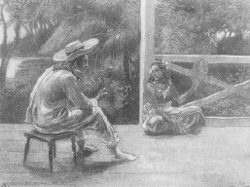 fig 8
Gordon Browne, Wiltshire and Uma from ‘The beach of Falesa,’ in Island nights' entertainments, London 1893, Edinburgh, National Library of Scotland, The Trustees of the National Library of Scotland Polynesian audience, sending copies of his ballads to Princess Moe and King Kalakua for instance, and having a Samoan translation made of one of his South Sea tales. Gauguin made occasional sales in the South Seas, but only to fellow colonials. Their attitudes to the local women differed. The character of Uma in The beach of Falesa was Stevenson's only serious attempt at writing about a Polynesian woman, and she charmed his readers. Told in the first person from the point of view of Wiltshire, a white trader, and based, according to Stevenson, to a large extent on fact, The beach of Falesa describes how Uma is duped into a bogus ‘marriage’ with Wiltshire, ‘for one night.’ Yet Uma avoids becoming the clichéd innocent victim one finds in much exotic literature, notably in Pierre Loti's Rarahu. The beach  fig 9
Cover of Island nights' entertainments, London 1893, Edinburgh, National Library of Scotland, The Trustees of the National Library of Scotland of Falesa also deals with superstitions and taboos. ‘I have got the smell and look of the thing a good deal,’ Stevenson boasted to Sidney Colvin. ‘You will know more about the South Seas after you have read my little tale, than if you had read a library.’Ga naar voetnoot39 (This artistic aim, of concentrating the essence of the place into the individual work of art, is comparable to Gauguin's.) But to his dismay, aspects of the story, particularly the hypocritical marriage document, were considered too hard-hitting, and were censored by the editors before it was allowed to appear in the Illustrated London News in 1892. Nevertheless, when his stories were published in New York and London in April 1893, under the collective title Island night's entertainments and with evocative illustrations by Gordon Browne, the book sold out within a week (figs. 8 and 9). | |
[pagina 68]
| |
In general, Stevenson's attitude to such commonplace cross-racial couplings was relatively tolerant. However, his tolerance disappeared when they involved his immediate family. When his stepdaughter Belle, his amanuensis, became the injured party due to her drunken husband Joe Strong setting up a secret ménage with a local girl, Stevenson did not hesitate to evict Strong from his home as an immoral scrounger. As we know, Gauguin, with no immediate family around to hold him back, had no such moral scruples, ‘marrying’ at least two native girls during his stays in Tahiti and fathering several children. The first of his native brides was Teha' amana, whose name and family origins he evokes in the painting Teha' amana has many parents of 1893 (The Art Institute of Chicago). Of course, Gauguin had come with a mission to paint the native women, the legendary vahines. Before his departure from France, he even painted and sculpted his imagined Eve in her sexually available, ideal, uncivilised form. Here he made his first use of a specific, non-Polynesian visual source that continued to inspire his paintings once in Tahiti: namely photographs of early Buddhist friezes from Borobudur, which he had acquired in France. There were further salient differences in their personal approach to understanding the tropics. Stevenson, during his boyhood in Scotland, had spent time exploring islands in the company of his father, a lighthouse engineer. A visitor from New Zealand had awakened his interest in the islands of the South Seas in the early 1870s. Unlike Gauguin, he had no childhood nostalgia for the tropics, nor does he seem to have had Gauguin's rose-tinted, utopian hopes of the ease of life there. The powerful myth of Tahiti, dubbed ‘La Nouvelle Cythère’ by Bougainville in 1768 because it fulfilled Enlightenment intellectuals' dreams of paradise on earth, was more entrenched in French culture than in British. And because the proposition of the South Sea voyage was dropped in Stevenson's lap, he did not have the same protracted period of anticipation that we find with Gauguin. Although he was happy to publicise the novelty of his undertaking, he did not claim to be returning to his primitive roots, or promise to write about an earthly paradise. Pretty quickly, the harsh reality was being confessed in his copious letters home. To his mother he wrote in January 1891: ‘Installation on a South Sea Island is not all roses, by several fathoms.’Ga naar voetnoot40 Ironically, where Stevenson's South Seas writing, both non-fiction and fiction, set out to be and was in fact considered less romantic, more realist, objective and dramatic than his readers had come to expect,Ga naar voetnoot41 Gauguin's Polynesian art became less and less bound by modern reality, which in its colonial form was undoubtedly a severe disappointment to him, more subjective, symbolist, idealising. Gauguin gives us scant evidence of interrelations between islanders and colonists apart from depicting the missionary costumes worn by the women. White men are totally excluded from his vision. However, the complex cross-cultural colonial realities are brought more to the fore in his multi-layered working methods. Part photo album, part sketchbook, part fictionalised account of his own life on Tahiti, Noa noa, which Gauguin compiled between 1893 and 1895, belongs in the category of traveller's journal. The pages of writing are interspersed with his own watercolour sketches and woodcuts, as well as with photographs, which, as has been recently shown, were produced for the colonial market and probably bought from local traders in Papeete.Ga naar voetnoot42 One photograph he owned, of a figure drinking from a waterfall, was long thought to be by the American photographer Charles Spitz. Spitz's authorship is now no longer so clear, and the photograph has recently been shown to represent a Samoan. In 1893 Gauguin used it as the basis for his painting Pape moe (private collection). Quantities of such photographs were on display and sale at the 1889 Exposition Universelle in Paris, which was where, indeed, Gauguin bought his photos of the Borobudur frieze. It is possible that we may yet find that Stevenson and Gauguin were in possession of some of the same photographic images. Certainly they met and, in Stevenson's case, photographed and took down stories from some of the same colourful and illustrious figures among the Tahitian islanders.Ga naar voetnoot43 Although Stevenson introduced a lot of the speech patterns he discovered in Polynesia into his late writings, much as Gauguin used Tahitian words as titles for his paintings, in the final analysis, Gauguin's art, with its cultivated primitivism, makes a more pretentious claim to going native. We have to infer his European point of view from the titles of his works and from the somewhat arch, philosophical puzzles they pose; from his multiple references to a western classical tradition; from the air of heavy languor he gives his figures, which invites us to | |
[pagina 69]
| |
muse on the sense of a past glory lost. The retrospective and nostalgic mood characteristic of certain paintings from his first Tahitian stay - for example Matamua (Times gone by) of 1892 (Madrid, Thyssen-Bornemisza Collection) - becomes more pronounced on his second trip in works such as Te reroia, or The dream, executed in 1897 (London, Courtauld Institute Galleries). Where Gauguin cultivated mystique and obscured meanings, Stevenson was open about his own Eurocentrism, whilst at the same time striving to bring in a Polynesian point of view. His concern was to uncover scams, to shine an unflinching light on to dark doings. Precisely because he paints realistic, modern pictures of Pacific life, because he explores the moral ambiguities of that colonial encounter with humour and irony, I would argue that Stevenson's writing is a vital and vibrant context within which to approach Gauguin's Tahitian art and to gauge the sometimes-wilful opacity of its symbolism. Could we but be sure that Gauguin knew of Stevenson's wide-ranging ambitions to write in a new way about Polynesia, we would be able to pose the further question: did that knowledge serve as an endorsement or an irritant, a spur or an inflection of his own artistic project? |
|

